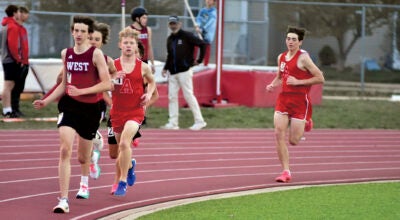Balance of Life: YMCA chosen as case study site for research on healthy aging programs
Published 6:35 am Wednesday, October 23, 2019
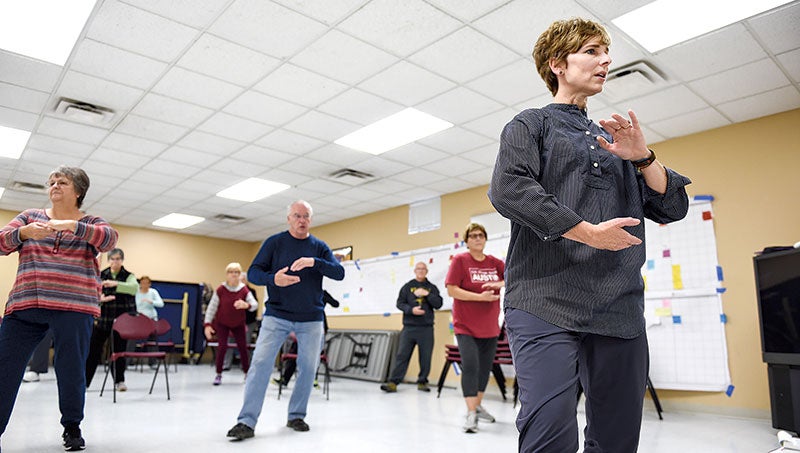
- Brigette Rambadt leads participants in a tai chi Tuesday at the YMCA. Photos by Eric Johnson/photodesk@austindailyherald.com
Downstairs at Austin’s YMCA, a group of 15 people were meditative and focused as their instructor led the class through a series of movements. Brigette Rambadt, program coordinator for Moving for Better Balance, started the class off with some warm-ups, and then moved into a series of movements.
“How do you feel about going in a circle?” Rambadt asked the class. To which some hesitated, but proceeded with caution as they slowly turned around in place while working on their knee joints. “Brush the knee, hold the ball right. Take and grasp the peacock’s tail.”
“Hoo boy,” one participant responded, drawing a laugh from the class.
They were all part of a new class at the YMCA called Moving for Better Balance, a 12-week evidence-based, instructor-led group that’s designed to help improve strength, balance, flexibility and mobility through slow therapeutic movements based on Tai Chi.
Through these steps, the class participants were already feeling the muscles in their knees, arms and thighs being worked out during the exercise. While focusing on their thoughts, they tried to forge a deep connection with themselves and their classmates.
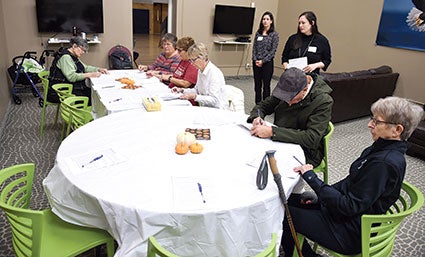
Participants in a study by the University of Chicago’s NORC answer questions on a survey Tuesday at the YMCA.
Classes are held from 9-10 a.m. on Tuesdays and Thursdays at the YMCA and 4-5 p.m. on Tuesdays and Thursdays at the Mower County Senior Center. A YMCA membership is not required to be a part of these sessions.
Working through the class, Diane Arends of Austin teaches some of the Stay Active and Independent for Life (SAIL) classes over at the Mower County Senior Center. There, she sees more adults up to the age of 93 beginning to socialize with one another and find a type of friendship and bond that may have been long forgotten about.
However, as she grows older, Arends shared that the classes she took through the YMCA better prepared her on how to work on balance as the risk of falls increases as time passes.
“I can use all the help I can get,” the 68-year-old said. “Working on my balance has kept me from having a few falls. Like when I went to Europe, those cobblestone streets are so uneven, and some of those falls can be fatal. I see more people at the center needing more balance, and then you see how far they’ve come.”
Another attendee in the class also has been working on his balance from a prior class and started attending the Moving for Better Balance program at the Y. Jack Heather of Blooming Prairie said that while older generations are beginning to be more wary and aware of the risk of falls, younger folks may not necessarily be thinking about those potentials at this point in their life.
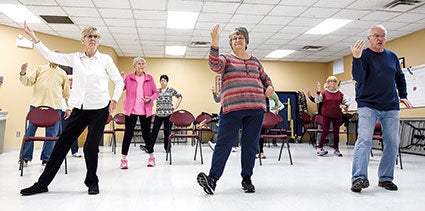
Participants move through a routine during a yoga class Tuesday at the YMCA
“Balance really comes second nature to them,” he said. “They don’t think about stumbling and then ending up in the hospital. You never really hear younger people talk about balance and how it works into your routine. You get into conversations with your doctor, and balance and falls come into play. As you age, the conversation changes.”
Not only are the Moving for Better Balance classes helping the aging with improving balance, it’s also serving another purpose as a focus group for a research study on combating isolation.
The NORC of The University of Chicago is conducting an evaluation of the Social Connectedness and Healthy Aging Grant Program that’s administered by the YMCA of the USA. This program looks to advance the Y’s healthy aging programming with a focus on improving the quality of life and increasing social connectedness. Y-USA supported 36 local Y’s to recruit older adults over the age of 55 to participate in traditional social and wellness programs and chronic disease prevention programs.
Alycia Bane, principal research scientist for the NORC, shared that social connectedness protects the health of the aging population during that time isolation can occur. When Bane searched for a specific YMCA to conduct her on-site visits, she heard of Austin’s YMCA’s programming and decided to choose it as one of two YMCAs across the country to use in the study.
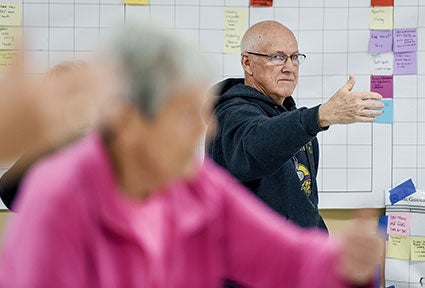
Jack Heather takes part in a yoga class at the YMCA Tuesday. He also took part in a survey on aging with the University of Chicago’s NORC.
“We chose Austin based on its excellent healthy aging programs,” she said. “This study really takes a look at programs that help reduce social isolation, which is a major public health issue. Through this study, we’re hoping to understand how the Y’s improving of connectedness with older adults improve their quality of life.”
While conducting an evaluation, the NORC looks to address three main questions in their research:
Do older adults report better quality of life and social connectedness through Y engagement?
What factors influence older adults’ outcomes related to quality of life and social connectedness (number of interactions with the Y, types of engagement, longevity of relationship with the Y)?
What are successful Y programs and models for improving the quality of life and social connectedness in the older adult population?
To answer these questions, Bane said that the study is in two-parts. One is conducting a mail survey of 1,800 Y members to study the outcomes of the Y’s programming on the older adults’ quality of life and social connectedness. Looking to the before and after results, the participants will share with researchers what their experiences were like and how the healthy aging programs benefited them.
The scientists would then conduct case studies and site visits with the two Ys, looking at the focus groups with older adults served by the organization, and interviews would be held with staff members who serve their older members. The results should show how this approach contributes to quality of life in older adults.
The actual study is expected to be finished some time in 2020.
“This study will contribute to the body of literature to help understand social connectedness among the aging,” Bane said.


